Novelty Clashes with Tradition
Atila S. Guimarães
Some of our readers are asking TIA for solid evidence that the introduction of the Luminous Mysteries by John Paul II was a progressivist initiative. They don’t agree with these new mysteries, which hurt their Catholic sense, but they don’t know how to justify their reaction. Was adding these new mysteries against the wish of Our Lady? Was it against the teaching of previous Popes?
I will try to answer these questions and give some assistance to these readers.
Origin of the Rosary
No Catholic doubts that St. Dominic of Guzman had a decisive role in the dissemination of the Rosary. In the year 1214 he received a revelation from Our Lady in Toulouse, France, telling him to place the new Order of Preachers he had founded under her protection through the praying and spreading of the Rosary.
Some scholars, however, discuss whether or not the Rosary of St. Dominic was the exact same one that we say today. They argue that a practice of glorifying the Virgin by offering her a spiritual “crown of roses” or mystical “ensemble of roses,” or yet a “garden of roses” (rosarium in Latin), was already a widespread practice among the simple medieval people before St. Dominic. These “roses” would consist in the repetition of the greeting of the Archangel Gabriel, Hail Mary full of grace ... that constitutes just the first part of the present day prayer. The medieval people would repeat that angelical greeting because it summarizes all the joys of the Most Holy Virgin in her life.
So, for these scholars, Our Lady would have only asked St. Dominic to follow that already existing but incomplete practice. The second part of the prayer – Holy Mary, Mother of God ... – would have been introduced later, along with the Our Fathers and the meditations on the sorrows and glories of Our Lady and her Divine Son. Only in the 15th century, in a revelation to Fr. Alain de la Roche, would the 15 mysteries in the form we know today have been established. Such is the opinion of this particular school. This opinion is very convenient for the Progressivists who promote the new luminous mysteries, since based on this reasoning they can pretend the Rosary has always been a changing and evolving prayer.
Other scholars disagree with this evolutionary school and consider that from St. Dominic on, the Rosary devotion was as it is now. They argue:
First, that the actual origin of the “crowns of roses” was established as a practice of the simple medieval people, who were not able to read and therefore could not pray the Hours of the Divine Office, also called the Psaltery, as was the habit among educated Catholics. Thus, instead of reciting the 150 Psalms, they started to pray 150 Hail Marys in honor of Our Lady as a substitute for the Holy Office. According to this school, from the very beginning, the Rosary included not only joyful meditations on the life of Our Lady and her Son, but also, inspired by the Psalms, sorrowful and glorious meditations.
Second, they say that it seems ludicrous and most improbable that Our Lady would ask St. Dominic to pray an incomplete Rosary, and then reveal to one of his disciples and other Catholics that what she really wanted was a complete Rosary. Given that she had intended to give us the complete Rosary, the prayer that most pleases her, this practice should have only one form, not two. Why would she, who is the Seat of Wisdom and always knew what she wanted to establish, conceal the complete form of the Rosary to the Dominican founder and only reveal it in the 15th century to one of his disciples? It is much more probable that she revealed the complete Rosary to St. Dominic, and when that devotion started to decline, she appeared again to reinforce the practice of that same original Rosary.
However, Progressivists considered the hypotheses of the evolutionary school as “proved” and started to treat the venerable tradition that says St. Dominic received the entire Rosary as a legend. Today, unfortunately, it is not rare to find this superficial interpretation promoted even in Dominican Institutions.
My sympathies are with the second school, and I have serious suspicions regarding the first. The latter fits neatly with today’s progressivist historic method of reexamining and changing almost everything that was already established by Church tradition. It also plays into ecumenism, which wants to minimize Marian devotions as much as possible to please Protestantism. We know that when Progressivists and Protestants cannot destroy a certain devotion, they try to sabotage it and present it as baseless and superstitious.
Leo XIII closes the discussion: St. Dominic received the complete Rosary
Further, this evolutionary and revisionist school conveniently “forgets” that the historical discussion was already closed a long time ago, when Pope Leo XIII decided the opposite of what it pretends. Indeed, he clearly affirmed that it was St. Dominic who received the entire Rosary with the three sets of mysteries.
In the Encyclical Octobri mense, Leo XIII affirms: “We are pleased to point out and strongly recommend the holy Rosary. To this manner of prayer was given, in common language, the name of ‘crown,’ because it recalls to our minds, in an opportune sequence, the great mysteries of Jesus and Mary: their joys, sorrows and triumphs.” (1)
In the next paragraph, the Pontiff completes his thought: “That the Queen of Heaven herself has granted a great efficacy to this devotion is demonstrated by the fact that it was, by her command and counsel, instituted and propagated by the illustrious St. Dominic, in times particularly dangerous for the Catholic cause.” (2)
That is, Leo XIII considers as historically proved (please, go to n. 3) that the three sets of mysteries he described were given as such by Our Lady to St. Dominic. In other words, according to this Pontiff, it was by the express wish of Our Lady that the three sets of mysteries were established.
The Most Holy Virgin confirms the three sets of mysteries
This decision was confirmed by the Most Holy Virgin in several of her apparitions.
In 1460, more than two centuries after that first communication to St. Dominic, when the Rosary devotion was in decline, she appeared to another Dominican, Alain de la Roche, to confirm her first intention. She told him to spread the Rosary devotion with the same form: 150 Hail Marys distributed in three sets of five mysteries.
After placing the Rosary around his neck, Our Lady told Fr. de la Roche:
“My son, you know perfectly the ancient devotion of my Rosary, preached and diffused by your Patriarch and my Servant Dominic and by his spiritual sons, your religious brothers. This spiritual exercise is extremely agreeable to both my Son and to me, and most useful and holy for the faithful.
“When my Servant Dominic started to preach my Rosary … the reform in the world reached such heights that it seemed that men were transformed into angelic spirits and that Angels had descended from Heaven to inhabit the earth. … No one was considered a true Christian unless he had my Rosary and prayed it. … The prestige of the holy Rosary was such that no devotion was or is more agreeable to me after the august Sacrifice of the Mass. …
“I desire, therefore, that it [the devotion of the Rosary] be restored again in the Church for the consolation of a great number of souls. You will be the one to preach my Rosary, exhorting all the faithful to pray it devoutly. … The Rosary will be a most powerful weapon against Hell; it will subdue vices, destroy sin and conquer heresies. All those who will recommend themselves to me through my Rosary will not be eternally condemned.” (3)
In the apparitions of Our Lady of Pompeii in 1884, which were praised by Pius XII (see two paragraphs below), Our Lady said, “If you seek salvation, promulgate the Rosary.” She appeared with the same Rosary that we pray.
If some doubt remains that Our Lady wants the Rosary as she gave it to St. Dominic, we can see that in 1858 at Lourdes she taught Bernadette how to pray that same Rosary. This is affirmed by Pope Pius XI in the Encyclical Ingravescentibus malis: “And we do not wish to pass over in silence the fact that the Blessed Virgin herself, in our very epoch, has insistently recommended this manner of prayer when, appearing to an innocent girl in the Grotto of Lourdes, she taught her the recitation of the Rosary.” (4)
In the Allocution Venuti come siete, Pius XII also stressed that Our Lady, who appeared carrying her own Rosary in her hand, prayed the Rosary with Bernadette in Lourdes: “In Lourdes as in Pompeii, Mary wanted to demonstrate with countless graces how greatly pleased she is by this prayer, which she invited her confidante St. Bernadette to say, following the Hail Marys of the girl while slowly sliding the beads of her own beautiful Rosary, resplendent as the golden roses that shone at her feet.” (5)
In Fatima, something similar happened. In all the apparitions there, Our Lady, dressed in white, held her Rosary in her folded hands, and counseled the children to pray the Rosary. Further, in the last apparition of October 13, 1917, she also appeared as Our Lady of the Rosary, displaying the traditional Rosary.
Since in these apparitions Our Lady always expressed her desire for the Rosary to be prayed as we know it, why would she tell St. Dominic to pray a different Rosary? Nothing seems less probable. If she told all the other seers the same thing – to pray the Rosary as we know it – she certainly ordered the same to St. Dominic. Therefore, the old Dominican tradition is correct in attributing to St. Dominic the complete Rosary – the 150 Hail Marys, 15 Our Fathers and Glory be's and the three sets of mysteries. The revisionist and evolutionary school is wrong.
Therefore, Our Lady desires the Rosary as it has been prayed since St. Dominic, and nothing else. Hence, the innovation of John Paul II does not attend to her expressed wish. Rather it seems to sabotage it by introducing another set of mysteries at his own personal initiative.
The three sets of mysteries and the previous Popes
The Popes also confirmed with their authority the excellence of the Rosary.
Pope Urban IV in 1261, less than 50 years after the introduction of the Rosary by St. Dominic, approved it and gave special indulgences to the Confraternities of the Blessed Virgin that prayed the Rosary.
Pope John XXII (1316-1334) confirmed the excellence of the same fifteen-decade Rosary and increased those indulgences.
Pope St. Pius V (1566-1562) ordered the Rosary, as we know it today, to be prayed by all of Christendom and all the warriors fighting in the Battle of Lepanto. Due to this prayer, that Battle was miraculously won by the Catholic fleet. In honor of that victory, St. Pius V established October 7 as the feast day of Our Lady of the Rosary and considered the Rosary an official prayer of the Church.
It would take too long to recount all the Popes who praised and blessed the Rosary as we know it. (6) Let me only reproduce a text by Leo XIII where he presents five Popes who approved the Rosary:
“After having repeatedly encouraged … the recitation of the Holy Rosary, we, following the example of our predecessors, have endeavored to increase its importance by a more solemn cult. Sixtus V, of happy memory, approved the ancient custom of praying the Rosary; Gregory XIII instituted the feast of the Rosary, which Clement VIII afterward inscribed in the Roman Martyrology, and Clement XI extended to the whole Church; later Benedict XIII inserted it in the Roman Breviary. So, we, in perpetual testimony of our appreciation for this devotion, have decreed that said feast and its Office should be celebrated in the universal Church … consecrating to this devotion the entire month of October.” (7)
In his Encyclical Fidentem piumque, Pope Leo XIII opposes any change to the structure of the Rosary: “And that old usage that flourished among our forefathers ought to be preserved with religious exactitude or else restored, according to which Christian families, whether in town or country, considered it a sacred duty to gather together at close of day, when their labors were at end, before a statue of the Virgin and alternately pray the Rosary.” (8)
We can see, therefore, that in many important apparitions, Our Lady asks Catholics to pray the Rosary as we always knew it – the Creed, the introductory Our Father, three Hail Marys, and Glory be; and the body of 150 Hail Marys, 15 Our Fathers, and 15 Glory bes divided into three sets of five mysteries, the Joyful, Sorrowful and Glorious. It seems quite clear that the innovation of John Paul II is opposed to the expressed will of Our Lady.
After exposing the praises and comments of many Popes, as well as referring to the indulgences and blessings they gave for praying the traditional Rosary, it seems quite clear that to pray a different rosary of four sets of mysteries causes this rosary to lose the merit of those eulogies and blessings. In other words, whosoever prays the new sets of mysteries would seem not to benefit from the previous indulgences and graces.
In summary, far from being a benefit, this new set of Luminous Mysteries caused a serious damage. It subverted an august 800-year-old devotional practice. Adding an additional 50 Hail Marys was an extravagance that did not lead more persons to adopt the practice of the Rosary; it made it more difficult for those who already prayed it. This addition of John Paul II, introduced on a personal whim, seems to me a hypertrophy that is producing an atrophy in the devotion of the Rosary. I wonder whether this atrophy was actually intended to sabotage the Rosary devotion.
TRADUCCIÓN Fuente : Radio Cristiandad
LOS ENFRENTAMIENTOS DE LA NOVEDAD CON LA TRADICIÓN
http://www.traditioninaction.org/religious/d018rpLuminousMysteries.html
¿Fue la adición de estos nuevos misterios en contra del deseo de la Virgen?
¿Era en contra de la enseñanza de los Papas anteriores?
Origen del Rosario
Ningún católico duda que Santo Domingo de Guzmán tuvo un papel decisivo en la difusión del Rosario. En el año 1214 recibió una revelación de la Virgen en Toulouse, Francia, diciéndole que se coloque la nueva Orden de Predicadores que había fundado bajo su protección a través de la oración y la difusión del Rosario.
Nuestra Señora entrega el Rosario a Santo DomingoIglesia dominica del Santo Rosario, Roma
Algunos estudiosos, sin embargo, discuten si el Rosario de Santo Domingo fue exactamente el mismo que se reza hoy. Ellos argumentan que existía una práctica de glorificar a la Virgen ofreciendo una “corona de rosas” espiritual o mística “conjunto de rosas”, o aun un “jardín de rosas” (Rosarium en latín), práctica muy extendida entre el pueblo medieval antes de Santo Domingo.
Estas “rosas” consistirían en la repetición del saludo del Arcángel Gabriel, Ave María llena de gracia…, que constituye sólo la primera parte de la presente oración. El pueblo medieval repetía ese saludo angélico porque resume todas las alegrías de la Santísima Virgen en su vida. Por lo tanto, para estos investigadores, la Virgen sólo habría pedido a Santo Domingo seguir esa práctica ya existente, pero incompleta.
La segunda parte de la oración -Santa María, Madre de Dios…- habría sido introducida más tarde, junto con los Padrenuestros y las meditaciones sobre las penas y glorias de la Virgen y su divino Hijo.
Sólo en el siglo XV, en una revelación al Padre Alain de la Roche, se habrían establecido los 15 misterios en la forma que conocemos hoy en día.
Esta opinión es muy conveniente para los progresistas, que promueven los nuevos misterios luminosos, ya que, basados en este razonamiento, pueden pretender que el Rosario siempre ha estado en un cambio y fue evolucionando como oración.
Otros estudiosos no están de acuerdo con esta escuela evolucionista y consideran que desde Santo Domingo, la devoción del Rosario es como es ahora.
Sostienen:
En primer lugar, que el origen real de las “coronas de rosas” fue establecido como una práctica del pueblo medieval simple, que no era capaz de leer; y por lo tanto no podían rezar las Horas del Oficio Divino, también llamado el salterio, como era la costumbre entre los católicos cultos. Así, en lugar de recitar los 150 salmos, comenzaron a rezar 150 Avemarías en honor de la Virgen como un sustituto para el Santo Oficio. Según esta escuela, desde el principio, incluyó el Rosario no sólo meditaciones gozosas de la vida de la Virgen y su Hijo, sino también, inspirada en los Salmos, meditaciones dolorosas y gloriosas.
En segundo lugar, dicen que parece absurdo e improbable que la Virgen pidiera a Santo Domingo rezar un Rosario incompleto, y luego revelar a uno de sus discípulos, y otros católicos, que lo que realmente quería era un Rosario completo. Teniendo en cuenta que se había propuesto para darnos el Rosario completo, la oración que más le agrada, esta práctica debe tener sólo una forma, no dos. ¿Por qué Ella, que es la Sede de la Sabiduría y siempre supo lo que quería establecer, iba a ocultar la forma completa del Rosario al fundador Dominico? Es mucho más probable que Ella revelara el Rosario completo a Santo Domingo, y cuando esa devoción comenzó a declinar, Ella apareció de nuevo para reforzar la práctica de ese mismo Rosario original.
Sin embargo, los progresistas consideran las hipótesis de la escuela evolucionista como “demostrado “y comenzaron a tratar a la venerable tradición, que dice que Santo Domingo recibió todo el Rosario, como una leyenda.
Hoy en día, por desgracia, no es raro encontrar esta interpretación superficial promovida incluso en instituciones dominicas.
Mis simpatías están con la segunda escuela, y tengo serias sospechas sobre la primera. Este último se ajusta, perfectamente, con el método histórico progresista de hoy de volver a examinar y cambiar casi todo lo que ya fue establecido por tradición de la Iglesia. También juega en favor del ecumenismo, que quiere minimizar las devociones marianas tanto como sea posible para complacer el protestantismo.
Sabemos que cuando los progresistas y los protestantes no pueden destruir una devoción, tratan de sabotearla y presentarla como sin fundamento y supersticiosa.
León XIII cierra la discusión: Santo Domingo recibió el Rosario completo.
En Fátima la Virgen pidió el Rosario de quince decenas
Además, esta escuela evolutiva y revisionista convenientemente “olvida” que la discusión histórica ya estaba cerrada hace mucho tiempo, cuando el Papa León XIII decidió lo contrario de lo que esta pretende. De hecho, afirmó claramente que era Santo Domingo quien recibió todo el Rosario con las tres series de misterios.
En la Encíclica Octobri mense, León XIII afirma: “Estamos encantados de señalar y recomendar encarecidamente el santo Rosario. Para ello se dio esta forma de oración, en lenguaje común, el nombre de ‘corona’, porque recuerda a la mente, en una secuencia oportuna, los grandes misterios de Jesús y María: Sus gozos, penas y triunfos “. En el párrafo siguiente, el Papa completa su pensamiento: “que la Reina del Cielo misma ha otorgado una gran eficacia a esta devoción se demuestra por el hecho de que era, por su orden y consejo, instituido y propagado por el ilustre Santo Domingo , en tiempos particularmente peligroso para la causa católica”.
Es decir, León XIII considera como históricamente demostrado que las tres series de misterios que describió fueron dados como tales por la Virgen a Santo Domingo. En otras palabras, según este Pontífice, que fue por el deseo expreso de la Virgen que se establecieron las tres series de misterios.
La Santísima Virgen confirma las tres series de misterios
Esta decisión fue confirmada por la Santísima Virgen en varias de sus apariciones. En 1460, más de dos siglos después de que lo comunicara a Santo Domingo, cuando la devoción del Rosario estaba en declive, apareció a otro dominico, Alain de la Roche, para confirmar su primera intención. Ella le reveló la devoción del Rosario con la misma forma: 150 Avemarías, distribuidos en tres grupos de cinco misterios.
Después de colocar el Rosario alrededor de su cuello, la Virgen dijo al Padre de la Roche: “Mi hijo, que conoce perfectamente la antigua devoción de mi Rosario, predicada y difundida por mi siervo Domingo y por sus hijos espirituales, tus hermanos religiosos. Este ejercicio espiritual es extremadamente agradable, tanto para mi Hijo como para mí, y de lo más útil y sagrado para los fieles. Cuando mi siervo Domingo comenzó a predicar mi Rosario… la reforma en el mundo alcanzó tales alturas que parecía que los hombres se transformaban en espíritus angélicos y que los ángeles habían descendido del cielo para habitar la tierra… Nadie era considerado un verdadero cristiano a menos que tuviera mi rosario y lo rezara… El prestigio del Santo Rosario era tal que ninguna devoción es más agradable para mí después del augusto sacrificio de la misa… Deseo, por tanto, que la devoción del Rosario sea restaurada en la Iglesia para el consuelo de un gran número de almas. Predica mi Rosario, exhortando a todos los fieles a rezarlo devotamente… El Rosario será el arma más poderosa contra el infierno; someterá los vicios, destruirá el pecado y conquistará herejías. Todos los que se encomiendan a sí mismos a través de mi Rosario no serán condenados eternamente.
En las apariciones de la Virgen de Pompeya, en el año 1884, las cuales fueron elogiado por Pío XII, dijo la Virgen: “Si busca la salvación, promulgue el Rosario”. Ella apareció con el mismo rosario que rezamos.
Si queda alguna duda de que la Virgen quiere que el Rosario sea el mismo que le dio a Santo Domingo, podemos ver que en 1858, en Lourdes, enseñó a Santa Bernardita cómo rezar ese mismo Rosario. Esto es afirmado por el Papa Pío XI en la encíclica Ingravescentibus Malis: “Y no queremos pasar por alto el hecho de que la Santísima Virgen misma, en nuestra misma época, ha recomendado insistentemente esta forma de oración cuando, apareciendo a un inocente niña en la Gruta de Lourdes, Ella le enseñó la recitación del Rosario”.
Nuestra Señora de Pompeya recomienda el tradicional rosario
Pío XII también hizo hincapié en que la Virgen, que apareció con su propio rosario en la mano, rezaba el Rosario con Bernardita en Lourdes: “En Lourdes, como en Pompeya, María quería demostrar lo contenta que la ponía esta oración, que Ella invitó a su confidente Santa Bernardita a recitar los Avemarías, mientras deslizaba lentamente las cuentas de su propio y bello Rosario, resplandecientes como las rosas de oro que brillaban a sus pies”.
En Fátima, ocurrió algo similar. En todas las apariciones, la Virgen, vestida de blanco, contuvo el rosario en las manos cruzadas, y aconsejó a los niños a rezar el Rosario. Además, en la última aparición, del 13 de octubre de 1917, Ella también apareció como Nuestra Señora del Rosario, mostrando el rosario tradicional.
Dado que en estas apariciones la Virgen siempre expresó su deseo de que el Rosario se rezase como lo conocemos, ¿por qué Ella querría rezar un Rosario diferente? Nada parece menos probable.
Por lo tanto, la antigua tradición dominica es correcta en atribuir a Santo Domingo el Rosario completo -el de 150 Avemarías, 15 Padrenuestros y Glorias, y las tres series de misterios.
La revisionista y evolutiva escuela está errada. Por lo tanto, la Virgen del Rosario desea lo mismo que se ha rezado desde Santo Domingo, y nada más.
Por lo tanto, la innovación de Juan Pablo II no se compagina con su expresado deseo. Más bien parece sabotearlo, mediante la introducción de otra serie de misterios de su propia iniciativa personal.
Los tres juegos de misterios y los Papas anteriores
Los Papas también confirman con su autoridad la excelencia del Rosario. Urbano IV en 1261, menos de 50 años después de la introducción del Rosario por Santo Domingo, lo aprobó y dio indulgencias especiales a las Cofradías de la Virgen que rezaba el Rosario. El Papa Juan XXII (1316-1334) confirmó la excelencia de la misma, de los quince misterios del Rosario, y aumentó las indulgencias.
Nuestra Señora enseña el Rosario a Santa Bernardita en Lourdes
El Papa San Pío V (1566-1562) ordenó el Rosario, tal como lo conocemos hoy en día, para que se ore por toda la cristiandad y todos los guerreros luchando en la batalla de Lepanto. Debido a esta oración, la batalla se ganó milagrosamente por la flota católica. En honor de esa victoria, San Pío V estableció el 7 de octubre como el día de Nuestra Señora del Rosario y consideró el Rosario una oración oficial de la Iglesia.
Sería muy largo de contar todos los Papas que elogiaron el Rosario tal como lo conocemos.
Sólo reproduciré un texto de León XIII donde presenta a cinco Papas que aprobaron el Rosario: “Después de haber alentado en repetidas ocasiones… la recitación del Santo Rosario, que, siguiendo el ejemplo de nuestros predecesores, se han esforzado por aumentar su importancia por un culto más solemne. Sixto V, de feliz memoria, aprobó la antigua costumbre de rezar el Rosario; Gregorio XIII instituyó la fiesta del Rosario, que Clemente VIII después inscribió en el Martirologio Romano, y Clemente XI extendió a toda la Iglesia; más tarde Benedicto XIII lo insertó en el Breviario Romano. Por lo tanto, nosotros, en un testimonio perpetuo de nuestro agradecimiento por esta devoción, hemos decretado que dicha fiesta se debe celebrar en la Iglesia universal… y consagrar a esta devoción todo el mes de octubre”.
En su Encíclica Fidentem Piumque, el Papa León XIII se opone a cualquier cambio en la estructura del Rosario: “Y ese viejo uso, que floreció entre nuestros antepasados, debe ser conservado con exactitud religiosa, según la cual las familias cristianas, ya sea en la ciudad o el campo, lo consideran un sagrado deber, se reúnen al final del día, cuando sus trabajos han finalizado, ante una imagen de la Virgen y rezan el Rosario.”
Conclusión
Se puede ver, por tanto, que en muchas apariciones importantes, Nuestra Señora pide a los católicos rezar el Rosario, el mismo siempre –el Credo, la introducción: Padre Nuestro, tres Ave Marías, y Gloria; y el cuerpo de 150 Avemarías, 15 Padrenuestros y 15 Gloria; dividido en tres series de cinco misterios, Gozosos, Dolorosos y Gloriosos.
Parece bastante claro que la innovación de Juan Pablo II se opone a la voluntad expresa de Nuestra Señora.
Después de exponer los elogios y los comentarios de muchos Papas, así como una referencia a las indulgencias y bendiciones que dieron para rezar el tradicional Rosario, parece claro que para rezar un rosario diferente de cuatro series de misterios hace que este rosario de pierda el mérito de esos elogios y bendiciones.
En otras palabras, todo aquel que reza las nuevas series de misterios parece no beneficiarse de las indulgencias y gracias anteriores.
En resumen, lejos de ser un beneficio, este nuevo conjunto de misterios luminosos causó un daño grave. Se cambió esta práctica devocional de 800 años de edad, agregando un adicional de 50 Avemarías; lo hizo más difícil para aquellos que ya lo rezaban.
Esta adición de Juan Pablo II, introducido un capricho personal, parece una hipertrofia que está provocando una atrofia en la devoción del Rosario. Me pregunto si esta atrofia no será, en realidad, la intención de sabotear la devoción del Santo Rosario.
Gracias al Rosario, la Virgen dio la victoria en Lepanto |


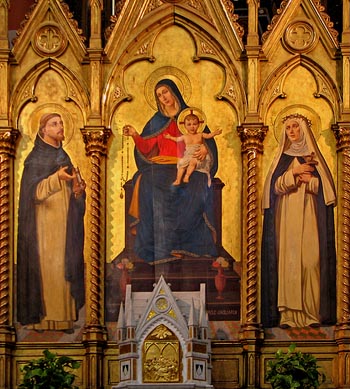
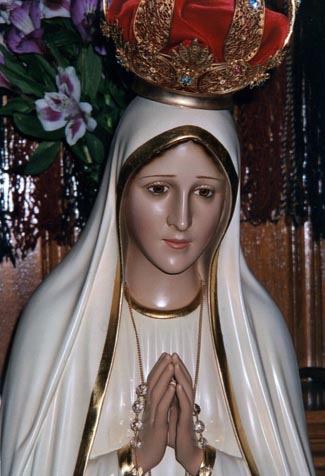
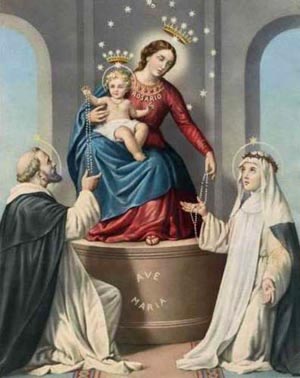
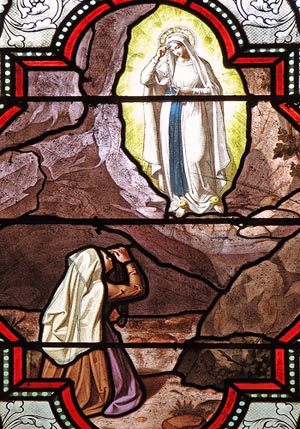
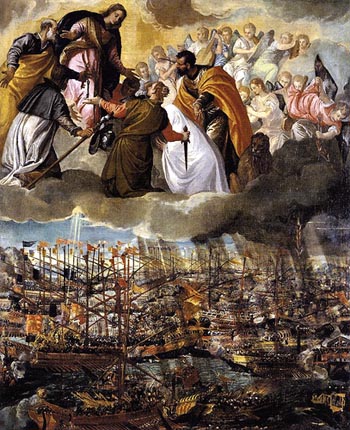
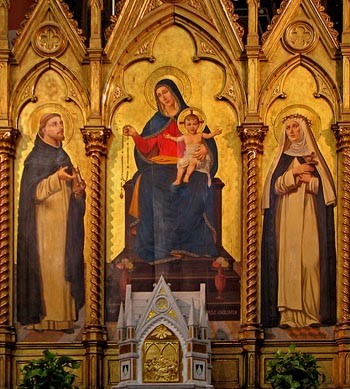
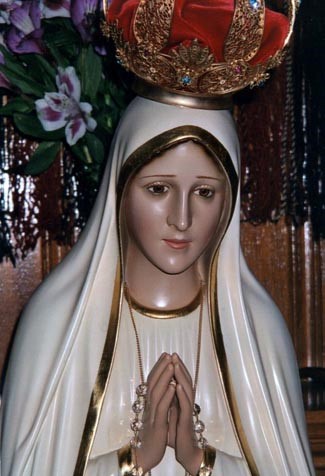


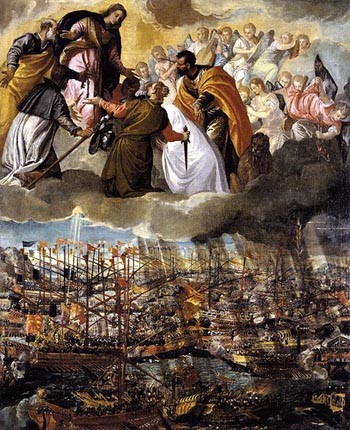

No hay comentarios:
Publicar un comentario